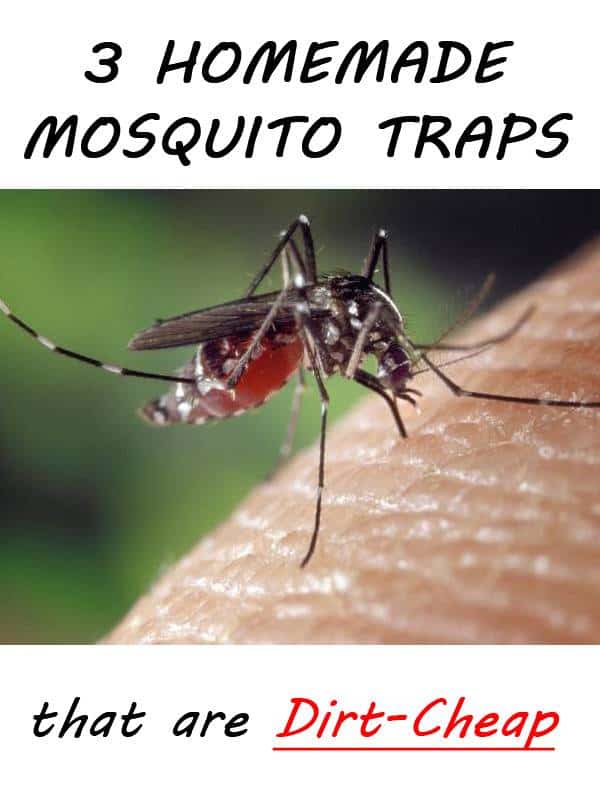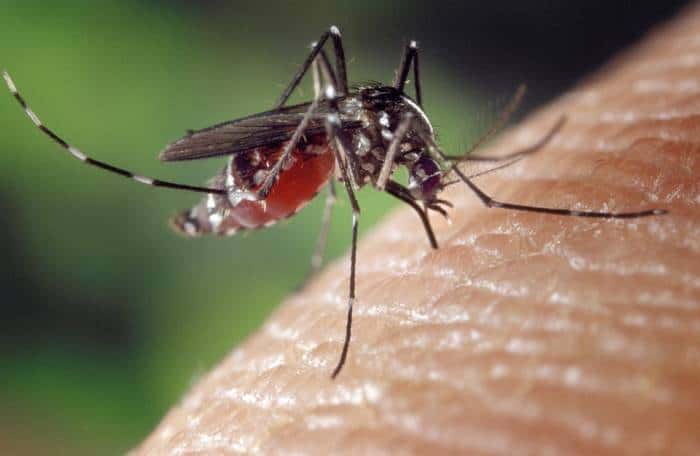Summer is my favorite time of the year, but I (like all of you, I imagine) could do without all the dang mosquitoes that come along with it. Trying to pull weeds in your survival garden while getting the blood sucked out of your legs and arms by those vile insects, is absolutely no fun at all.
You could dig into your wallet and buy a host of commercially manufactured mosquito traps, OR go the nearly free and equally effective route and DIY mosquito traps to place around your homesteading survival retreat.
For the best results with any mosquito trap, you will need to place them in two distinctive spots on your property: around low-lying wet areas (especially near the woods) and where you will be enjoying or working in the great outdoors on any given day.
To trap mosquitoes it is important to learn more about them and their habits. The blood-sucking insects follow the path of carbon dioxide trails – you know, the stuff we humans produce as we inhale and exhale. If you are lounging or working by a fire, even more mosquitoes will be headed in your direction.
Diseases mosquitoes can carry include: encephalitis, West Nile, and malaria.
Mosquito Facts
1. More than 3,500 different species of mosquitoes are flying about our planet.
2. Only the female of the species actually feed on our blood. The lady mosquitoes must ingest blood in order for their eggs to develop properly. A single female mosquito can lay up to 300 eggs in a single clutch.
3. Mosquitoes are attracted to not only carbon dioxide, but also to sweat, body heat, and dark clothing.
4. Mosquito eggs are laid upon the surface of standing stagnant water, they must have water in order to hatch. It takes about 10 days of squirming around in the water for the insects to mature into mosquitoes.
5. Being a mosquito means, among other things, that you are going to have a really short life. The insects only live for approximately two months.
DIY Mosquito Trap #1 – Plastic Bottle Trap
This simple homemade mosquito traps really does work quite well, but will have to be refilled on a regular basis to continue being effective. Sugar and yeast are used for mosquito bait. The neck of a plastic bottle a carbon dioxide pathway and serves as an entrance to the trap. It has a “Hotel California” effect – the bugs can get it, but they never check out. When the trap is made properly, the mosquitoes eventually exhaust themselves trying to get back out of the bottle and fall to the bottom and die.
Materials
• Yeast – 1 package of dry: approximately 3 teaspoons
• Brown sugar – ¼ of a cup
• 1 cup of hot water
• Plastic bottle – you can use one 2-liter plastic bottle or several single plastic water bottles placed around the perimeter to where you are recreating or working.
• Scissors or knife.
• Duct tape
• Black paint or construction paper
Directions
1. Remove the cap from the bottle and discard.
2. Cut the top part of the bottle (the neck and funnel area) off. You want to cut just below the flare of the bottleneck.
3. Turn the bottleneck and funnel piece upside down so the mouthpiece where the cap was is pointing to the bottom of the bottle.
4. Push the inverted bottleneck down slowly and carefully. You must leave enough space at the bottom to hold the yeast and sugar mixture – at least a couple inches.
5. Tape the two bottle pieces together to hold the funnel section firmly in place. This helps ensures no gaps will appear between the two bottles that would allow the mosquitoes to escape.
6. Paint the lower section of the bottle or tape black construction paper around it to help attract the insects.
7. Make and pour in the yeast, sugar, and water mixture – see instructions below.
Mosquito Trap Bait Instructions
1. Boil the water.
2. Pour in the sugar and stir until it completely dissolves while slowly reducing the heat to a simmer.
3. Let the mixture cool to around 120 to 130 degrees. Pouring the yeast in when the mixture is too hot can kill the yeast and doing so is when it is too cold will not allow the yeast to activate properly.
4. Pour in the yeast and stir.
5. Pour the bait into the DIY mosquito trap.
6. Set the trap where it is most likely to attract mosquitoes.
DIY Mosquito Trap #2 – Biting Fly Trap
DIY Mosquito Trap #3 – Fan Trap
Top 5 Other Ways To Prevent Mosquito Infestation And Bites
1. Bats – Place bat houses in the trees to lure them to wooded areas near your home. Bats love to come out at dusk and dine on a nice big hefty mosquito meal.
2. Citronella – You can buy or make citronella candles as well as rub some citronella essential oil onto your skin or make a homemade natural spray using it as a primary ingredient to keep the blood-thirsty insects at bay.
3. Garlic – Place whole garlic cloves or sprinkle garlic powder around an area where you will be sitting or working to keep mosquitoes away. Garlic is believed to be toxic to mosquitoes. You can also mix a few pinches of garlic powder into the plastic bottle trap bait mix just in case a few mosquitoes do escape the funnel in hopes the garlic will kill them dead before they have the chance to bite anyone else.
4. Herbs and Plants – Cultivate plants and herbs that have been known to repel mosquitoes around your home, barn, workshop, etc. Some of the top mosquito repelling herbs and plants include: basil,lavender, bee balm, clove, catnip, rosemary, citronella grass, lemon balm, mint, and eucalyptus.
5. Beer – Place opened cans or bottles of beer around the area where people gather or work to attract and then drown, the mosquitoes that can’t resist the yeast and hops smell and fly inside. It is best to pour half of the beer out to ensure the mosquito can’t simply lean in from a dry position of safety to enjoy a sip of the beer.
No single type of mosquito trap is likely to rid your survival retreat from mosquitoes once and for all. You will have to remain diligent and use/refill the traps regularly, and eliminate as many potential spots that will attract the insects throughout the year.

Tara Dodrill is a homesteading and survival journalist and author. She lives on a small ranch with her family in Appalachia. She has been both a host and frequent guest on preparedness radio shows. In addition to the publication of her first book, ‘Power Grid Down: How to Prepare, Survive, and Thrive after the Lights go Out’, Dodrill also travels to offer prepping tips and hands-on training and survival camps and expos.


Thanks Tara, I will experiment with some of these suggestions
OggyMn,
I hope you have great success. Please comment back and let us know what worked best for you!
I would like to see a result video
Has anyone used these methods and have they had results? I do know that the electronic bug “zappers” will not work with mosquitoes, as mosquitoes are attracted to CO2, literally our very breath. Does the yeast fermenting create enough CO2 to attract them?
One idea would be to go where there is a heavy mosquito population, such as an undrained swimming pool, et al- and implement one of these methods, then get back to us with results.
Kristin, it’s been 6 months, what are the results of your research?
I did give it a try and left the bottle outside in my lawn for the night. Next morning i checked around 11 AM and it was filled to the brim with Flies. So this definitely works for flies, for mosquitos im not so sure.
Works great for flies, gnats, and mosquitos and a variety of others. Better than any electronic or battery operated products.
Which trap did you build?
Well, mosquitoes get into our house easily and sometimes keep me up at night, so I made the plastic bottle trap last night in the hope that I would be able to sleep properly. I can only say that I am thankful there was only one mosquito, because it completely ignored the trap and went for me without hesitation. I had to stay up for a while to kill it, then finally I was able to sleep a little. Feeling a little groggy this morning.
Maybe it works in principle, if there are no other more appealing targets nearby. Or maybe the fact that I didn’t paint or wrap it in something dark (because I thought it would be too dark in my room to matter) was the problem.
It dawns on me, though. How do you empty it so you can fill it with fresh bait? Do you have to remove the tape so you can take the top part off?
It doesn’t matter that it’s dark in your room to you, mosquitoes see infrared, not on the same spectrum as you.
When I prepared and placed the traps, the frequency of mosquito bites was greatly reduced. When I emptied the bottles of the mixture, I found only a few mosquitoes. Can anyone explain why?
Thank you for providing information on how to make the traps. They did help!